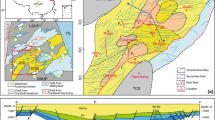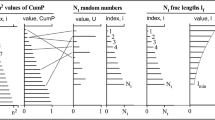Abstract
Detailed box counting analysis was conducted of (1) fractures observed in exposures of the Devonian Shale in the central Appalachians Valley and Ridge Province of West Virginia, (2) several fracture patterns presented in the literature, and (3) active faults mapped throughout the main island (Honshu) of Japan. Box curves reveal, with few exceptions, that most naturally occurring fracture patterns are characterized by nonfractal behavior. In many cases, two linear regions separated by an abrupt transition are observed in the logN/logr box curves. The small-scale (larger r) features generally have higher fractal dimension than do the larger scale features in the pattern. Transitions from one region to another are usually abrupt. These transitions are not associated with sampling problems or other data limitations. In some cases three or more linear regions may appear. Box counting analysis of model fracture patterns indicate that transitions are related to the dominant spacing of individual sets or to the dominant fragment size in the network. This study provides detailed documentation of scale invariant features in natural fracture and active fault patterns. Although the relationship of the geometrical properties of a pattern to the location of transitions is understood in terms of the models, to understand the physical mechanisms responsible for these transitions deserves further study.
Similar content being viewed by others
REFERENCES
Barton, C. C., 1995, Fractal analysis of scaling and spatial clustering of fractures, in Barton and LaPointe, eds., Fractals in the Earth Sciences: Plenum Press, New York, 265 p.
Barton, C. C., and Hseih, P. A., 1989, Physical and hydrologic-flow properties of fractures, 28th International Geological Congress Field Trip Guidebook T385: American Geophysical Union, Washington, DC, p. 36.
Berkowitz, B., and Hadad, A., 1997, Fractal and multifractal measures of natural and synthetic fracture networks, J. Geophys. Res., v. 102 no. 6, p. 12205–12218.
Chiles, J. P., 1988, Fractal and geostatistical methods for modeling a fracture network: Math. Geology, v. 20, no. 6, p. 631–654.
Gillepsie, P. A., Howard, C., Walsh, J. J., and Watterson, J., 1993, Measurement and characterization of spatial distribution of fractures: Tectonophys., v. 226, p. 113–141.
Gonzato, G., Mulargia, F., and Marzocchi, W., 1998, Practical application of fractal analysis: Problems and solutions: Geophys. J. Int., v. 132, p. 275–282.
Hirata, T., 1989, Fractal dimension of fault systems in Japan: Fractal structure in rock fracture geometry at various scales: C. H. Scholz and B. B. Mandelbrot, eds., Journal of Pure and Applied Geophysics, v. 131, nos. 1/2, p. 157–170.
Kanamori, H., and D. Anderson, 1975, Theoretical basis of some empirical relations in seismology: Bull. Seism. Soc. Am., v. 65, p. 1073–1095.
Matsumoto, N., Yomogoda, K., and Honda, S., 1992, Fractal analysis of fault systems in Japan and the Philippines: Geophysical Research Letters, v. 19, no. 4, p. 357–360.
Odling, N. E., 1992, Network properties of a two dimensional fracture pattern: Pageoph., v. 138, p. 95–114.
Okubo, P., and Aki, K., 1987, Fractal geometry in the San Andreas fault system: Journal of Geophys. Res., v. 92, no. B1, p. 345–355.
Pacheco, J. F., Scholz, C., and Sykes, L., 1992, Changes in frequency-size relationship from small to large earthquakes: Nature, v. 355, p. 71–73.
Research Group for Active Faults of Japan, 1980, Active faults in Japan: Sheet maps and inventories: University of Tokyo Press, 363 p. (in Japanese).
Research Group for Active Faults in Japan, 1991, Maps of active faults in Japan with and Explanatory Text: University of Tokyo Press, Hongo, Bunkyo-ku, Tokyo 113, Japan, 437 p.
Research Group for Active Tectonic Structures in Kyushu, 1989, Active tectonic structures in Kyushu, Japan: University of Tokyo Press, 553 p. (in Japanese).
Scholz, C. H., 1982, Scaling laws for large earthquakes: Consequences for physical models, Bull. Seismol. Soc. Am., v. 72, p. 1–14, 1982.
Scholz, C. H., 1990, The mechanics of earthquakes and faulting, Cambridge, Cambridge University Press 439 p.
Scholz, C. H., 1995, Fractal transitions on geological surfaces, in Barton, C. C., and LaPointe, P., eds., Fractals in the earth sciences; Plenum Press, New York, p. 131–140.
Scholz, C. H., 1997, Size distribution for large and small earthquakes: Bull. Seismol. Soc. Amer., v. 87, p. 1074–1077.
Scholz, C. H., 1998, A further note of earthquake size distribution: Bull. Seismol. Soc. Amer., v. 88, p. 1325–1326.
Shimazaki, K., 1986, Small and large earthquakes: The effects of thickness of the seismogenic layer and the free surface, in Das, J. B. S., and Scholz, C., eds., Earthquake Source Mechanics. AGU Geophys. Mono. 37, American Geophysical Union, Washington, DC, p. 209–216.
Turcotte, D. L., 1989, Fractals in geology and geophysics, in Scholz, C. H., and Mandelbrot, B. B., eds., Pure and Applied Geophysics: p. 171–196.
Turcotte, D. L., 1992, Fractals and chaos in geology and geophysics: Cambridge University Press, Cambridge, 221 p.
Wallace, R. E., 1973, Surface fracture patterns along the San Andreas Fault, in Kovach, R., and Nur, A., eds., Proc. Conf. Tecotnic Problems of the San Andreas Fault System: Spec. Publ. Geol. Sci. 13, Stanford University Press, Palo Alto, CA, p. 248–250.
Walsh, J. J., and Watterson, J., 1993, Fractal analysis of fracture patterns using the standard boxcounting technique: Valid and invalid methodologies: Jour. Structural Geology, v. 15, no. 12, p. 1509–1512.
Wilson, T. H., 1999, Non-fractal size-scaling attributes of fracture trace and active fault networks with examples from the central Appalachians and Japan: Geol. Soc. America Abstracts with Programs, v. 31, no. 7, p. A112.
Wilson, T. H., 2000, Size scaling relationships in fracture networks: Final Research Report of Work Conducted on D. O. E. Contract DE-FG26-98FT40385, 89 p.
Wilson, T. H., Dominic, J., and Halverson, J., 1997, Fractal interrelationships in field and seismic data: Final Research Report of Work Conducted on D. O. E. Contract DE-FG21-95MC32158, 162 p.
Author information
Authors and Affiliations
Rights and permissions
About this article
Cite this article
Wilson, T.H. Scale Transitions in Fracture and Active Fault Networks. Mathematical Geology 33, 591–613 (2001). https://doi.org/10.1023/A:1011096828971
Issue Date:
DOI: https://doi.org/10.1023/A:1011096828971




